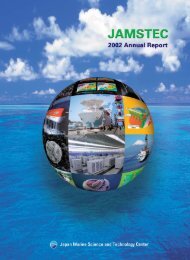2007 Annual Report - jamstec japan agency for marine-earth ...
2007 Annual Report - jamstec japan agency for marine-earth ...
2007 Annual Report - jamstec japan agency for marine-earth ...
Create successful ePaper yourself
Turn your PDF publications into a flip-book with our unique Google optimized e-Paper software.
Paleoclimate and Paleoceanography Group<br />
a. Research activities in the field<br />
To clarify changes in the Amur River discharge as related<br />
to changes in past Asian summer monsoon activity, we participated<br />
in a cruise of the R/V Khromov during August-September<br />
<strong>2007</strong> and collected sediment cores along the Sakhaline coast,<br />
inside the Russian exclusive economic zone (EEZ). We also<br />
participated in the Wakashio Maru cruise (one day in every<br />
month) and collected living planktic <strong>for</strong>aminifera to understand<br />
their ecology and to develop a new biological "thermometer" -a<br />
proxy <strong>for</strong> sea surface temperature (SST)-by using the Mg/Ca<br />
recorded in the planktic <strong>for</strong>aminiferal carbonate tests.<br />
Fig.12 Sediment core sample locations.<br />
Red circle, Okhotsk Sea; blue circle,<br />
off Shimokita peninsula.<br />
b. Research topic: Changes in intermediate-deep water circulation<br />
in high latitudes of the North Pacific associated with the<br />
B/Å warm event during the last deglaciation.<br />
What will happen to the ocean environment in the near<br />
future as global warming progresses? We can learn the oceanographic<br />
responses to global warming from climate changes that<br />
occurred in the past during the deglaciation from 1.9 ka BP to<br />
1.1 ka BP, across a millennial time scale without the influence<br />
of human activity.<br />
We focused on the Heinrich 1 (H1) cold event (17.5-14.6<br />
ka BP) and the Bølling/Ållerød (B/Å) warm event (14.6-12.9 ka<br />
BP). We reconstructed past ventilation changes in intermediatedeep<br />
water in the Okhotsk Sea (water depth, 1215 m; Fig.12),<br />
which is a source region <strong>for</strong> North Pacific Intermediate Water<br />
(NPIW), and off the Shimokita peninsula in the northwestern<br />
North Pacific (water depth, 1366 m; Fig.12), which is a downstream<br />
region of NPIW. We used 14 C age differences between<br />
coexisting benthic and planktic <strong>for</strong>aminifers from sediment<br />
cores to determine ventilation age (Fig.13). Because NPIW is<br />
considered to be an important temporal carbon reservoir,<br />
changes in its temperature and ventilation rate would change its<br />
carbon capacity.<br />
In the waters off Shimokita, the 14 C age differences<br />
changed in response to the millennial time scale warm and cold<br />
events; differences were relatively small during the H1 cold<br />
period and large during the subsequent B/Å warm period<br />
[Ahagon et al., 2003] (Fig.13). In the Okhotsk Sea, we could<br />
not identify definite differences in ventilation ages corresponding<br />
to the H1 and B/Å events because of the sparse data due to<br />
poor preservation of <strong>for</strong>aminifer shells (Fig.13). However,<br />
slower ventilation during the last glacial maximum (LGM) was<br />
inferred from the older ventilation age in the Okhotsk Sea (Fig.<br />
13), suggesting that the <strong>for</strong>mation of Okhotsk Sea Intermediate<br />
Water (OSIW), which is an important source of NPIW, was<br />
reduced during the LGM [Okazaki et al., 2008]. One probable<br />
cause of the slow ventilation at intermediate depths in the<br />
Fig. 13 Ventilation ages at intermediate depths (1000 m) in the<br />
Okhotsk Sea and off Shimokita peninsula. Pink fill, warm periods; gray<br />
fill, cold period. See text <strong>for</strong> explanation of abbreviations.<br />
Okhotsk Sea is the reduced <strong>for</strong>mation of dense shelf water<br />
(DSW) because of perennial sea-ice covering the source area of<br />
DSW in the Okhotsk Sea.<br />
The Mg/Ca ratio in benthic <strong>for</strong>aminiferal shells, which is a<br />
proxy <strong>for</strong> bottom water temperatures, indicates that the bottom<br />
water temperature at a depth of 1366 m off Shimokita during<br />
the B/Å warm period was 2 to 3 C higher than that during H1<br />
(data not presented; Kimoto et al., 2008). Furthermore, a high<br />
CaCO3 content was found simultaneously during the B/Å warm<br />
period in sediments from the Okhotsk Sea (data not presented),<br />
which is a source area of NPIW, implying that good carbonate<br />
preservation (deepening of the carbonate compensation depth)<br />
was caused by a warming and reduced ventilation rate of intermediate-deep<br />
water. It seems that the notable changes at the sea<br />
surface propagated rapidly to intermediate-deep water, and the<br />
temperature and ventilation age in intermediate-deep water and<br />
the carbon cycle changed in response to climate changes across<br />
the millennial time scale represented by the B/Å warm period.<br />
References<br />
Ahagon et al., 2003: Geophys. Res. Lett., 30,<br />
doi:10.1029/2003GC000559.<br />
Kimoto et al., 2008: Chikyu Monthly, 30(4), 182-188.<br />
Okazaki et al., 2008: Geophys. Res. Lett., submitted.<br />
27
















